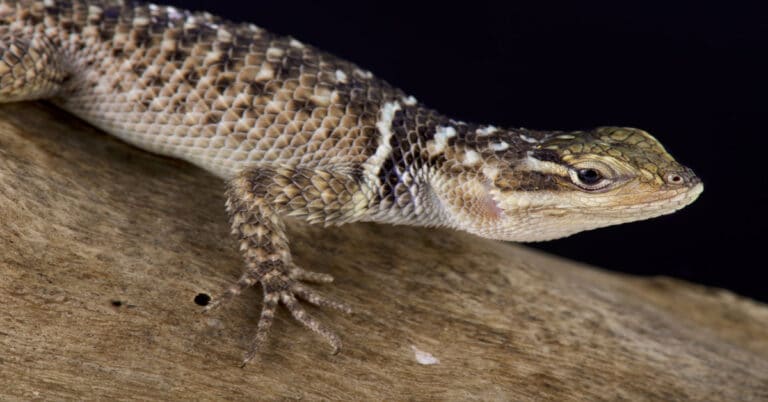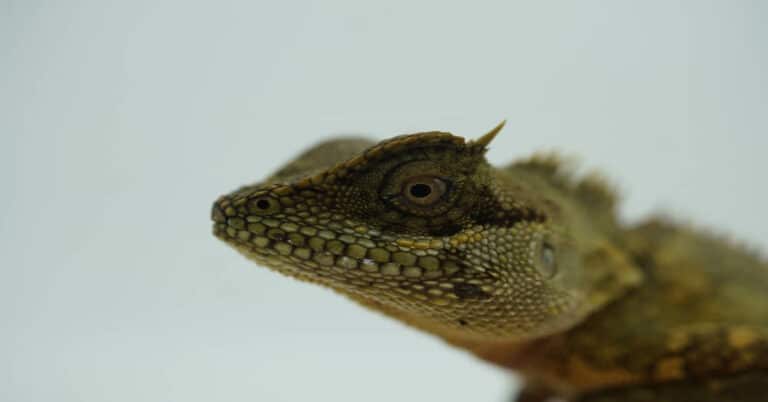Types of Lizards
Lizards are reptiles, belonging to the class Reptilia, and live in almost all of the continents apart from Antarctica. Lizards can thrive in diverse climatic conditions and are the most geographically widespread of the reptiles. Thus, it allows them the undisputed status of the largest group of reptiles with about 5000 species. They have survived on the earth for about 200 million years.
Reptiles have the following physical features: they have vertebrae, lungs, and scales or plates. They are cold-blooded, drawing all of the body heat from the environment (the sun) which can be deadly during cold spells. This enables them to consume less food compared to a mammal having the same body weight; this can particularly benefit them in the desert. They like to lay in the sun in order to heat themselves.
Usually, most of the lizards have four legs, but some might have two or no legs at all. The average lengths of lizards are between 2 inches to about 10 feet. Among the other members of the class, the Mexican Beaded Lizard and Gila Monster are vicious.

Size
While the biggest member of the lizard family, Komodo monitor has the ability to grow even longer than an adult human, the smallest one is a little gecko.
Features
Usually lizards tend to have parched, and rough skin, with four legs, feet having claws and a fragile lengthy tail. The opening of the ear outside is visible, and they can detach their tail very easily in case of little jerk or disturbances. Thus, the enemies get confused. However, it is vital to note that not all of the lizards have weak and frail tails. The tails help them to balance the body and move ahead. Lizards store extra fats in their tails, thus it can be a major problem for them when the tail breaks off. Some of them are capable of growing new tails.
Their Diet
Lizards feed on bugs, spiders and other insects. Some eat plants, tiny animals and other lizards.
Lizards look for food through their eyes, and some even use smell-sense to find food.
They have strong jaws and teeth. The teeth are also present at the top of the mouth.
Habitat
Lizards can adjust in a wide range of habitats including deserts, forests, swamps or rocky areas. Fields as well as trees, are ideal living spots for them.
People enjoy watching lizards, which are mostly operative during the summer and hibernate in winter. If temperatures are excessively high, some of them may hide, coming out only to fetch food.
Movement
Lizards can trot, crawl and even cling to some surface or branch. A few exceptional ones can swim as well. You can see them laying over rocks or moving through logs. Many lizards can trot fast through the grounds, except the ones having unsteady legs that tend to travel slowly.
Reproduction
Most of the lizards keep the eggs in the nests, except the ones who give birth to babies. The child-bearer doesn’t seem to care for the young ones.
Enemies
Lizards have to survive, amongst numerous enemies like birds, snakes, lizards and other animals.
Defenses
Lizards can move or detach their tails, hiss or swell up to get rid of enemies. Some can change colors and camouflage. Some lizards are deadly for humans, thus it is vital to be careful as they might bite or bear pointed spines.
Other Threats
Human beings are really hazardous for lizards. They often feed on lizards or their eggs. Earlier, lizards have been killed for their skins.
The rapid development of towns and farms destroy the habitats of the lizards. Successive attempts to catch and examine lizards by setting up traps have gone in vain.

In the Leuser Ecosystem, there has been a wide variety of lizards such as skinks, gecko, cicaks (smaller, less colorful cousins of geckos) or monitor lizards along with frogs.
The skink is similar to the gecko, being dark green in color and twists while it moves. The 7-8 cm long skinks feed on mosquitoes. The gecko is about 10-11 cm in length, having orange and green spots and living on tiny cicaks and flies. The monitor lizard feeds on animals which are smaller than it. They are light green with stripes of dark green and an average length around 1 meter. Cicaks are night lizards with a green color, feeding on mosquitoes. During night time, they wait near lights to catch mosquitoes and other flies.
Being green in color, the meat eater Komodo dragons hide in grass. Residing in the island of Komodo, they feed on cattle, dogs, cat even human beings. The 10 foot long lizards can be seen in the Zoo in Singapore.
The lizards are undoubtedly very important as many carnivores feed on them including the humans. The monitor lizards are particularly very essential as the Chinese communities show interest in certain parts of the lizard body. They believe that eating the eyeballs of the monitor lizard can offer them immortality. The skin of the monitor lizard and the meat is also very expensive. They also offer spectacular attractions in zoos.
Beginners Pet Lizards
Many people are not aware of the fact that reptiles are actually very nice pets, if properly taken care of. In order to keep reptiles at home, ample amount of research is necessary so that you can cut down the cost as well as time. Even the pet stores might fail to deliver you correct information about proper caring of reptiles; as a result, you may find the hobby of lizard-keeping quite expensive.
Amidst the wide variety of lizards existing on this planet, only some can be excellent pets, while the others can be threatening for an amateur keeper. Here are three types of pet lizards which a novice hobbyist can manage easily and can be fun as well.
The Bearded Dragon

The bearded dragons are the most popular species of pet lizards for all types of keepers. Once you fulfill their basic demands, they will live a long and healthy life. They also have very obedient nature.
Pagona family of reptiles comprises of eight members, commonly referred as bearded dragons.. The name commonly refers to the central bearded dragon, (Pogona vitticeps), which refers to the portion below the throat that turns to black color if they are under stress. The main habitat of these reptiles is dry, rough, rocky areas or the open woodlands of Australia.
The original homeland of the “Beardies” is Australia, but you can easily create a suitable environment for them by using full-spectrum lighting or basking lights. This way, you can keep them at home.
The Bearded dragons are small in size, and thus, a beginner who wants to keep lizards can easily manage and handle them. They can fit comfortably in plastic or glass terrariums that you can place anywhere in the house.
Being omnivorous in nature, you can easily feed the”Beardies” with vegetables if you have difficulty in supplying insects. Thus, it is not very difficult to keep them as pets.
The Uromastyx

Many often refer to the spiny-tailed Uromastyx as “uros” in short. They are another variety of lizards that make good pets.
The uromastryx originates from a tropical and torrid environment, even though they reside in several parts of the planet, from North Africa to India. However, it is not an impossible task to replicate the environment, especially for the people residing in North America. They are also very easy to feed as they eat both vegetables and insects.
The uro exists in a wide range of colors. There are about sixteen varieties of this lizard, and therefore you find wide variations in appearance according to their location. Even though they are tiny in size, the Uromastyx are excellent pets having very little care conditions (You can keep the basking of relaxing spot at 120 degrees F)
Blue-Tongued Skink

The Blue-tongued skinks form the part of the Australasian genus Tiliqua. It comprises some of the major members of the skink group (Scincidae) who are huge in size. In Australia, they are usually famous as blue-tongues or blue-tongued lizards. The popular feature of this type is the unique tongue of vibrant blue color, which they put out at times to scare away enemies. Most people raise them for selling and keeping as pets.
The blue-tongued skink, as the name itself suggests, has a vibrant blue colored tongue in contrast to the pink coating of its mouth. Even though they reside mainly in dry or semi-desert areas, one can easily create the ideal environment for them. A huge sized cage with some materials for creating borrows will suit the pet ideally. You should provide your pet with an average temperature of 80-100 degrees for their comfort and relaxation.
Residing across several parts of Australia, New Guinea or Tasmania, the blue tongued skinks become good pets as you can domesticate them easily. Like the other domestic lizards, the blue tongue skinks feed mainly on 60% vegetables and 40% animals. Vegetables, fruits, chicken or turkey meat, insects and even rodent, constitute their favorite food items.
Some of the Other Lizards

Otherwise called Chamaeleonidaes, these lizards are one among the renowned species in the world. The well-known variety is the West Usambara two-horned chameleon. They can adjust their color to the surroundings and merge with the environment. Their success in hunting lies in their slow, leaf-like movements and their precise aim. There are 160 species of these lizards; they are natives of Madagascar, Portugal, Africa, South Asia and Spain. In addition, you can find them in Florida, Hawaii and California.. Their habitat is warm climate (differs from deserts to rainforests. They feed on insects (Big varieties of chameleons consume little lizards and tender birds.
Chameleons reside in trees, having leaf-shaped flat bodies. They can camouflage and wait silently to catch their prey. Their eyes can perceive all around, even up and down. Thus, they can easily spy on the prey without moving their heads.; Moving slowly and stirring their bodies in a to and fro movement like leaves shaking in the wind, their clever movements easily trick the prey. They have specially adapted grippers and tales to balance their body, and to crawl and move. The prehensile tail also helps them to grasp tree branches and also fold its spiral shape for smooth movement.
Interesting Fact: The Chameleon has very keen eyes; they can simultaneously focus on two different objects, and this faculty easily facilitates their climbing and hunting activities.. They are capable of grasping branches and balancing with the help of their spiral tail.

Glass lizards belong to the Anguidae family. Most of them are limbless, slow in movement and are hence, trappable easily. In order to divert the attention of their predators, similar to other lizards they shed their tails. Few are skilled in climbing trees. These lizards are natives of China, North Africa, India, Southeastern United States and North Africa. With 94 species, Slow-worms and eastern glass lizards are the most well-known ones; they inhabit vast extension of areas (Plain forests, deserts, and the like). Their diet consists of earthworms, slugs, young rodents, hairless caterpillars and small reptiles.
Interesting Fact: These lizards resemble snakes, they are limbless. Many recognize them as lizards because of their head shape and for their movable eyelids and ears opening externally.

The earless monitor lizards belong to the lanthanotidae family, are natives of Northern Borneo, they live in burrows and they are nocturnal animals. This single species is rare, as such, not much is known about them. They measure 20 cm in length, There have rough scales on their body, small limbs and ears and live on land and water. They feed on earthworms.
Interesting Fact: Despite the name, this rare lizard is capable of hearing, although it lacks visible signs of ears.
Earless, Spiny, Side-Blotched and Horned Lizards

Belonging to the diverse Family “Phrynosomatidae” that has almost 136 species, they are native to South Canada and Panama. They inhabit sandy and hot deserts (in certain areas, rocky deserts). A clear majority of them acclimatize to rocky and desert life. In order to protect themselves against their predators, they have spikes on their body. These lizards hunt by camouflaging and trapping their prey. They feed on grasshoppers, worms, ants, beetles, crickets, some type of plants and flies.
Interesting Fact: The desert horned lizard spurts blood from its eye, to a distance of 5 feet when attacked
Skinks

Skinks belong to the Family of Scincidae, and after the geckos, they are second in the diversified family of lizards. They are from South Asia, Central United States and Australia. With 1200 species, they inhabit grasslands, deserts, burrows and mountains. The most famous of them are the Eastern blue-tongued lizard. Most of this variety has lengthened bodies with no visible neck and comparatively very small legs. Certain varieties do not have legs. They feed on small rodents, grasshoppers, caterpillars, crickets and beetles.
Interesting Fact: On account of the deep blue tongue of the lizard, most people mistake it as a poisonous type of lizard, but it is false. When aggravated, these Blue-tongued skinks just exhibit its conspicuous blue tongue to threaten probable predators.
Spectacled Lizards

Belonging to the Gymnophthalmidae family, you will find these lizards in South and Central America. With 200 (disputed species) of them, their most popular variety is the Leposoma Rugiceps. They inhabit the rainforests, mountains and deserts. Most of the spectacled lizards have tiny limbs and are normally small in size. When compared to the fore limbs; the hind limbs are negligible in size or missing. On the whole, they appear like Skinks. Their diet mainly consists of insects.
Interesting Fact: Spectacled lizards can see with closed eyes. These lizards have their lower eyelids transparent, that move (dissimilar to the geckos). This gives them the name ‘spectacled.’
Spinytail lizards

These are from the Cordylidae family. They are natives of the Eastern and Southern parts of Africa. There are 71 species of these lizards, of which the well known one is the Tropical girdled lizard. They inhabit tree trunks, in the cracks of rocky territories and burrows. The peculiar characteristic of this lizard is the thick shield made of scales, rectangular in shape oriented in standard lines all along its tail and body. In most of the varieties their tails have spiny rings which act as a shield to their predators. They are insectivores.
Interesting Fact: On the pet market, the tropical girdled lizard comes from Mozambique and Tanzania. By providing sufficient hiding places and with careful management, you can train these wonderful animals to take food from the hands of their keeper, and become their favorite pets.
Collared Lizard

These lizards belong to the Family, Crotaphytidae. There are 12 species in this family; the most well known ones are the Eastern collared lizard and the Common collared lizard. They are natives of Northern Mexico and South west of the United States. Their habitats are semi-dry and dry lands. They have long limbs and tail that helps them to move fast. A few are famous for their speedy running on their hind legs. They are usually seen in deserts, they appear like tiny dinosaurs. Geographical range: Southwestern United States and Northern Mexico. They feed on small mammals, insects and other lizards.
Like the Chameleons, there are some other lizards that can, according to the environment, alter their body colors faster. The color shades might be affected by the sun. While lazing exposed to the sun, the lizard’s skin often becomes dynamic and lively which happens in case of a Collared Lizard, Cold lizards are usually dark without any color.
The unmistakable color and special features, such as a vibrant red dewlap, yellow spots or blue tongue help the lizards to recognize one another, and communicate. They have a specific body language and gestures for communicating with each other, as their eye sights are not very sharp.
The Collard Lizards shed the layer of earlier keatin coatings. They are also of combative nature, and feed on other lizard groups.
Interesting Fact: The clear black band round their neck and down to their shoulders, resembling a collar, gives them the name Collared lizards It is the state reptile of the state of Oklahoma in the United States
Tegus and Whiptails

These lizards belong to the Teiidae family. They are natives of South Central and North America. They inhabit the tropical forest regions. There are 230 varieties of these lizards, of which the most famous species are the white and black Argentine Tegu and the Gold Tegu. The peculiar characteristics of the lizards of the Teiidae family are their forked tongue like that of a snake, and the scales on their head. They have fully developed limbs. They feed on eggs, insects, carrion, fruits, seeds, small vertebrates and all types of arthropods.
Interesting Fact: Most of the population of the whiptail lizards or all of them are females. Their production takes place through parthenogenesis (a sexual reproduction process without a male sperm).
True or Wall Lizards
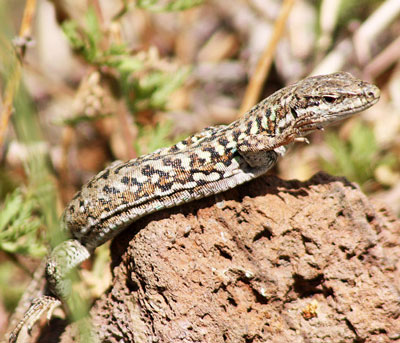
These lizards belong to the family of Lacertidae. They inhabit places like Asia, Africa and Europe. With around 200 species like the popular Italian wall lizard, they inhabit the diverse rocky, dry areas, deserts, grasslands and forests. Their characteristic features are a lengthy tail with different colorful designs and slim body. The scales are rectangular in shape beneath, granular on the back and big scales on the head. Their diet consists of seeds and insects.
Interesting Fact: Most of the wall lizards are sexually dimorphic that means the females and males have diverse designs on them.
Wood Lizards, Clubtails

They belong to the Hoplocercidae family. They are found in the provinces of South and Central America. Among their 10 varieties, the well known specie is Dunn’s spiny tail lizard. They inhabit the forests of the tropics. This family of lizards is mainly terrestrial. They search small insects and prey in the forests of the tropical regions. Their characteristic features are spiny tail, which acts as a tool to dig shallow holes in the ground. Little is known of this lizard family. Their diet chiefly consists of small insects, crickets and worms.
Interesting Fact: Wood lizards live in privacy; they are smart, and frequently conceal themselves under logs and in burrows. This makes it difficult to conduct research on these lizards.
Iguanas and Spiny tail Iguanas

These lizards belong to the Iguanidae family, They are natives of central America, Northern Mexico, Southern Brazil and the Caribbean islands. With a disputed number of 39 (recognized) species, they inhabit marine and arboreal places. Green iguanas are popular reptile pets in the United States and are more or less the biggest ones in America. They measure approximately 6.5 feet in length and weigh almost 11 pounds (5 Kilograms). They feed on growing shoots, leaves, sea weeds, fruits and flowers.
Iguanas are a popular food item for the Central Americans, who even calls them “tree chicken”. Many call the black iguana as “garrobos”, while the green ones they call just iguanas. They prepare common dishes along with the Iguana’s charbroiled tail. Usually the hunters attack them with with slingshots and hang the freshly hunted iguanas for arresting potential buyers’ interest. People eat the spiny-tailed lizard, also known as Uromastyx in India and Middle Eastern and North African countries.
Iguanas can swim as well. If they find themselves in danger they will jump into water and swim.
Common Iguanas are fairly good swimmers. When something attacks them, iguanas can jump from a rock or a tree and escape by swimming away into the water.
The Marine iguanas are exclusively inhabitants of the Galapagos Islands. Speculation is rampant that they might have floated across the debris of South America to reach the Islands. They often dive about 50 feet in water to eat algae, and stay below for maximum 20 minutes. To stay under water for a long time, initially they use the sun’s rays to warm their bodies. They slow down the hearts in water and then heat their bodies when they emerge out of the water.
Interesting Fact: An iguana lives on an average, for 20 years, and in captivity they live for a lesser period, because several owners are ignorant of the real knowhow of nurturing these iguanas.
Casquehead Lizards (Basilisk/Jesus Christ Lizard)
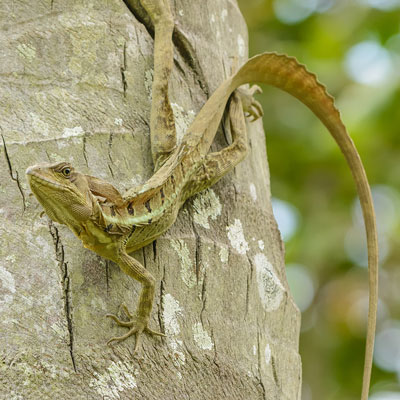
Also called Basilisk- this Jesus Christ Lizard belongs to the Corytophanidae family. There are two species, Brown basilisk and Common basilisk, they are natives of Central America, Mexico and Ecuador, and they are arboreal. They acquired this “casque” name from their specially well formed head crest shapes that resemble a casque. Only the males of few varieties have them and use it to good effect for defending themselves. Their flat body is for climbing, and their tails help to balance their movements. They mainly feed on small vertebrates. Their diet consists of brown basilisk, insects, small vertebrates like birds, fish, eggs, flowers, snakes and fish.
Interesting Fact: The hind feet of the basilisk lizards are big having flaps of skin between their toes, they are otherwise named Jesus Christ lizard, This web facilitates them to run on water with speed. The special features of the Basilisks are that they can run very fast, standing straight on their hind legs and even run or at least walk on water if required; hence the name “Jesus Christ Lizard”.
Tuatara

The nocturnal tuatara, they say, has remained the same for about one hundred and forty million years. It is a member of the reptilian class but not of the family of lizards, but of Rhynchocephalia that arrived on this planet almost before 220 million years. The other Beakheads, along with the tuatara became extinct creatures somewhat Sixty million years back.
Chuckwallas

The Chuckwallas reside mainly in rocky areas of Mexico and Southwestern USA. As soon as they find themselves in danger, they crawl in gaps and bloat their bodies so that no one can pull them out. The special third eye in the head helps them to find out whether it is daytime or nighttime.
Horned lizard

The Thorny Devil or the “Horned Devil,” also known as Devil lizard or Horned lizard, stays away from danger by shooting out blood from its eyes and thereby frightening its predators. Spiny protuberances cover its body. Presence of narrow apertures amidst the scales allows them to grab drops of rain or dew up to its mouth through capillary action.
There are large variations among the horned lizards. Almost all of them love eating black ants, catching them with the aid of sticky tongue. A healthy adult might eat even up to five thousand black ants in a day.
Flying Dragon Lizard

Flying lizards are also referred to as “butterfly lizards” because of their vibrant colored wings. The wings are basically flaps of the skin, which helps them to travel from one tree branch to another. It uses its tail for directions or as a brake. Elongated dynamic ribs support the huge flaps, which function by expanding and retracting successively.
Gecko

The gecko is an exceptional lizard among the reptile family specially gifted with the ability to speak or bark. Some of the species have special toe pads for crawling through polished vertical areas or ceilings. Reports suggest that there are about 2,000 varieties of gecko lizards all across the globe. In the recent times, fossil research has shown the Eastern Himalayas as the home for Geckos for over 100 million years.
Geckos are from the Gekkonidae family; they are multi colored, small lizards
Geckos are small, colorful lizards that are specialists in climbing and adhering to the surface. With 1,500 species, they inhabit moderate climates all over the world. The most well known species are the leopard gecko and the Gold dust day gecko. Their typical sound discriminates them from the others, by way of which they communicate. In place of eyelids, they have a transparent membrane, so it is impossible for them to blink. They maintain their eyes clean and dust free by using their tongue that is long enough. They feed on other vertebrates and insects.
Pet advisors often recommend the Leopard Geckos as an ideal pet lizard for new keepers, because of their tiny size and simple caring conditions. A 15-29 gallon tank is ample for keeping these nocturnal creatures. They do not require any specialized lighting and you can feed them with a wide range of insects, and can easily handle them.
Interesting Fact: The Leopard gecko is the most popular pet lizard that at all times gives a smiling impression because of their particular formation of their mouth and head.
Frilled Lizard

This bright colored lizard is well-known all across the world because of its huge collar that also makes it very photogenic. The collar looks like a satellite dish and can inflate to 10 inches (26 cm) if erected.
The unique features of these lizards are their easy ability to inflate their normal sizes frighten enemies, and hiss after opening the frills near the neck whenever they find themselves in danger. Thus, they actually appear to be scary, and frighten away the adversaries.
Corytophanes Hernadezi or Hernandez’s Helmeted Basilisk

This Lizard originates from Belize
Yellow-spotted Night Lizard – Belize

Lepidophyma flavimaculatum or the yellow-spotted lizard is a nocturnal creature residing mainly around Mexico –Texas. Yellow spots which run steadily along the sides of the body from snout to rear flanks, cover their black bodies. However, the spots become thin and faint in the tails. You can further sub-group them to two members, Lepidophyma flavimaculatum Obscurum and Lepidophyma flavimaculatum flavimaculatum.
These yellow-spotted type of lizards are the largest variety of the nocturnal lizards with an average length of around 5 inches (12.69 cm). The head of the lizards is mild and gentle much like snakes, even though the body comprises of coarse skin. The teeth are black and tongues are white.
Agamas

Agamids are the lizards of the earlier world. There are about 300 varieties of agamids across Australia, Africa as well as Asia. In America, Iguanidae is the name for these types of lizards. While some of them thrive in water, others enjoy living in tree branches. Unlike the geckos, the agamids do not drop tails or generate it back, even though they can recover a little of it with time.
Agamids, also called “dragon lizards” or “dragons” belongs to the family Agamidae that take the slot for the most highly distributed lizards worldwide. You can find them in sizes ranging from five inches to one foot in length and in a diversity of colors. With about 300 species, they inhabit Asia, Australia, Africa and Southern Europe in a warm Environment and feed on eggs of smaller lizards, seeds, berries, grass and insects. The most popular lizards in this category are the Frill-necked lizards and the Rainbow Agama.
Interesting Facts: Spectacular body color markings on the males of some species during the breeding season is a special feature of these lizards. The color change has relevance to the behavior of this species during communication and reproduction.
American Legless Lizards (Anniellidae family)

These lizards belong to the Anniellidae family that includes six species in the Anniella genus. These lizards have no legs, their snout is like a shovel; they are lean and small, the scales are shiny and smooth and they have a blunt tail. Among them are the main two sub-species, Baja California legless lizard (Anniella Geronimensis) and the California legless lizard (Anniella. Pulchra) that inhabit mainly the sandy dunes all through the coast and the moist soils of Northern America. The biologists discovered four more sub-species in 2013. They feed on spiders, beetles, larval insects and terminates.
Interesting Fact: The exterior features of the legless lizards make them look like snakes. Snakes do not have eyelids, which the legless lizards have, this feature discriminates them from snakes.
Legless Lizards (Pygopodidae family)

These lizards also called slow worms, belong to the Pygopodidae family. They are natives of New Guinea and Australia. With 35 species, they inhabit burrows and dense coastal grasses called spinifex. The most known species is the Common scaly-foot lizard. They have tiny flattened flaps as vestigial hind limbs. They use the flaps for protection and it helps them to move along the vegetation. Most of them are burrowing animals. Their diet consists of smaller lizards and insects.
Interesting Fact: The astonishing hearing sense that these lizards possess compensates for their lack of limbs. They are can hear tones higher than most reptiles. Besides, they have the capability to vocalize. Giving out squeaks at high pitch.
Anoles
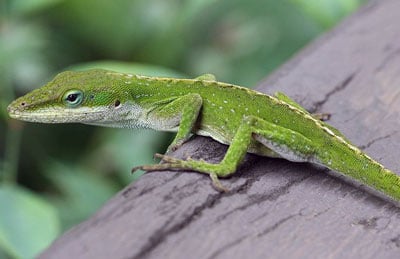
Belonging to the Polychrotidae family, these are tiny creatures usually visible adjacent to parks and houses. They are arboreal, with 400 species and inhabit North America, Cuba, Jamaica and South- Eastern regions of the US. A majority of them sport green, but some have a brown color. Depending on their moods and color, the Anoles will change their color. The well known varieties are Carolina Anoles and the Green Anoles.
Interesting Fact: Anoles of certain types are defensive and it is observed that few of them exhibit violent actions to their reflection in the mirror. These anoles eat cockroaches, bugs and spiders.
Blind Lizards

This variety of lizards belong to the Dibamidae family, They are blind and do not have exposed ears. Their eyes are hardly visible and are covered with scales. Females do not have limbs and the males have tiny hind limbs like flaps which they use for mating. They are natives of SE Asia, Philippine Islands, Mexico, Western New Guinea and Indonesia. With 22 species, of which the most famous are the Alfred’s Blind Skink, they dwell beneath the rocks in thick forests or in burrows in the soil. They feed on tiny insects.
Interesting Fact: Majority mistake blind lizards for worms. The reason being, a major portion of the time, the blind lizards dwell underground and their body is tiny and slim.
Knob-scaled Lizards

These are lizards belonging to the Xenosauridae family. They are natives of China and Central America. With 7 species, they inhabit the semi-dry scrub lands and semi-aquatic regions. Chinese crocodile lizards are popular species. Several species in the wild are rare and IUCN includes them in the list of vulnerable reptiles. The scales that cover their body are bumpy and rounded. They are very good swimmers and normally hunt water insects and tiny fish
Interesting Fact: The Chinese Crocodile lizard got its name because of its muscular tail and the big bony scales on its back (resembling a crocodile).
Madagascar Iguanids
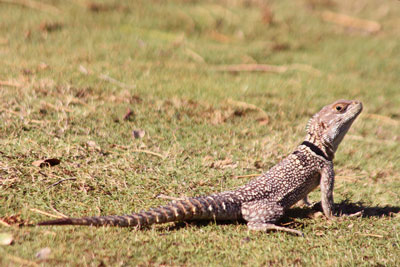
These originate from the Opluridae family. They are natives of Madagascar and with 7 species, their habitats are rocks, trees and sand dunes. The popular species are the collared iguana.
Description: Opluridae has 7 species under 2 genera. You find these lizards abundantly in Madagascar, the most famous species being collared iguana. They feed on flowers (occasionally) and insects
Interesting Fact: The features of Madagascan iguanas are very similar to the normal Iguanas. Research reveals that the DNA of the two groups splits up into two discriminating species a few million years ago.
Monitor Lizards

Monitor lizards belong to the Family of Varanidae. They live in the three continents, including the Indo-Australian islands and Australia, Africa and Southeast and south Asia. With the 67 species, they inhabit the mountainous regions, tropical rain forests, desert regions and the coastal regions. The well-known varieties are the Monitor Lizards and the Komodo dragon. This family comprises of a few of the largest existing lizards (Crocodile monitor and Komodo Dragon). The majority of the Varanidae family is big in size, having claws, sturdy tail and elongated necks. Their limbs are strong enough to dig holes and tear meat apart. They are carnivores.
Interesting Fact: The largest and most weighty earthly lizards are the Komodo dragons. The length of the biggest Komodo dragon ever seen is 10.3 feet (3.1 meters) weighing 366 pounds (166 Kg.)!
Neotropical Ground Lizards

Belonging to the Tropiduridae family, you will find these lizards in the West Indies and South America. There are 119 species of them. Most of them are ground dwellers (Gardens and Yards). The most famous of them are the Lava Lizards. Their patterns, color and size differ in accordance with the surroundings.
Interesting Fact: While battling for a mate, these ground lizards stands erect on all their four legs, with a sideways posture intended to appraise their adversaries of their larger than life image, and bob their heads up and down.
Night Lizards

These lizards belong to the Lizard family, Xantusiidae. You find them in Central North America, South-Western America and Cuba. There are 23 varieties of them of which the Desert night lizards are the most popular. They dwell in the damp logs and crevices in the rocks. These minute lizards grow to a size of 4 to 12 cm. They live in the interior of tree trunks and beneath rocks. All the varieties of Xantusiidae are viviparous (bringing forth alive ones). The body and head of these lizards are flat, Their eyes resemble the snake’s, with a transparent membrane covering it. They feed on termites, tiny insects and plants.
Interesting Fact: Night lizards bring forth 1-3 babies in a clutch. The juveniles stay with their parents and their kin for a period of one year. Despite this, these juveniles, approximately the size of a toothpick, are independent.
Plated Lizards

These belong to the family, Gerrhosauridae. They are natives of Madagascar and Africa. With 34 species, they inhabit the sand dunes and the crevices in the rocks. The most famous variety of this lizard is the Sudan Plated lizard. A few of the species belonging to this family have all their four limbs well developed while the rest of them possess only vestigial hind limbs. They have thick plates resembling scales which perform the function of a good shield as a defense to their predators. Their diet consists of vegetables, live crickets and small quantities of fruits.
Interesting Fact: Plated lizards have a passive and well disciplined comportment, and so, they make fine pets. These lizards are omnivorous. These lizards quickly adapt and are popular in pet shops among the lizards.
Gila Monsters and the Mexican Beaded Lizards
NOTE: Please do not confuse the Beaded lizard with the all time popular Bearded Lizard

These reptiles are of the helodermatidae family, comprising the venomous types. Beaded lizards and Gila monster are the two well-known species. They are sturdy, large and slow.. They are yellowish and dark in color, having pinkish markings on their body. With only 2 species in the family, they are natives of Gautemala, South west of the United States and Mexico. They inhabit the deserts and scrublands. They use this venom for protection only and not for restraining their prey. Their diet mainly consists of small mammals, rodents, reptiles and bird eggs.
Interesting Fact: Gila monsters do not require food very often; they survive for months up to a year without food as they can accumulate fat in their big tail.
New Discovery In May 2014
(Leaf-Tailed Gecko (Saltuarius Eximius)

Two enterprising biologists have now found a new Leaf-Tailed Gecko (Saltuarius Eximius) in Eastern Austrlia’s rain forest. Interestingly, in mid May, a scientific group, The International Institute for Species Exploration came out with a list of top 10 new species from a list of nearly 18,000 species discovered every year, out of which Arachnids and insects normally constitute more than 50%.
What the Lizard Cage Must Provide
There are five vital factors that you must keep in mind, while selecting the perfect cage for your pet lizards. The cage must be safe and secure, spacious, well lit and humid. Below is an elaboration of these five factors:
1. Security Requirements
The most vital factor for keeping lizards is their safety and security. Primarily, the cage must prevent the pets from running away, and also provide protection against intruders and other enemies such as cats or dogs. Some lizards tend to run away, thus it is always better to be on the safer side by using a professional cage, especially designed for keeping lizards. Without perfect skills, do not try to construct the cage.
2. Space and Orientation
An adult iguana can attain 6 feet in length; thus it requires a lot of space for moving comfortably. On the other hand, smaller species like the geckos need very little space. Also find out whether the reptile you are opting to adopt, prefers trees or grounds for relaxing. It is vital to gather proper information about the space orientation of the pet lizard you want to keep. Fulfill the conditions, before bringing them home to avoid future hazards.
3. Sufficient Lighting
Normally, a majority of the lizard species prefers the sun; only a few exceptional ones enjoy burrowing underneath the ground. Exposure to light is very vital for the cold-blooded animals. Apart from natural sunlight, full spectrum lights can fulfill the maximum requirements of your pet. Keep this in mind, when you buy the cage.
4. Heat Control
The first step is to gather proper information about the preferable temperature of your pet lizard. The next step is to bring home a cage which enables you to attain that particular temperature. Even inside home, you can control the heat in many ways, depending on the strength and durability of the cage.
5. Humidity Control
There are a few reptiles, which seek a high amount of moisture, while others thrive best in dry atmosphere. The tropical lizards require huge amount of humidity. Thus, find the suitable cage before you bring home the pets.
How to Care for Your Lizard
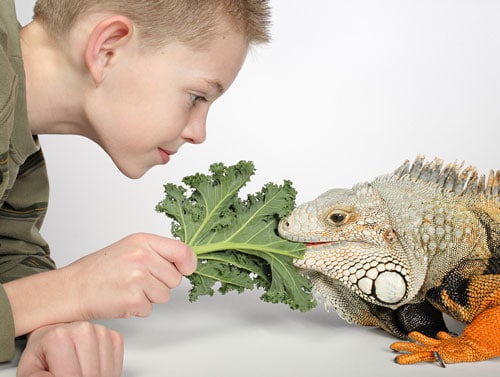
It is crucial to ensure that the cage is suitable for the pet. Usually, 2’x2’x2’ aquarium is ideal. Naturalize the inner space as much as possible. Put inside sticks, twigs, small plant branches and even dirt. Keep the space moistened for about 10 seconds twice or thrice each day. The lizard will draw the water droplets from the leaves. Some might also learn to drink it directly from a bowl.
Crickets, earthworms, spiders, wax worms, ants, butter worms, and small animals, are ideal food for your pet lizards while others feed on plants, and other lizards as well.
In order to allow your lizards to be healthy, maintain hygienic factors well. You should feed your lizards well and not allow them to grow skinny. In case the lizard feels limp in your hand, be sure it has some health problems. Regularly checking the stomach for burrs is a good idea. Check that the eyes are crystal clear. Crust around the eyes indicate ill health. Running nose and pale pink or gray shaded mouths are signs of sickness.
If possible, take it out of the cage from time to time, or at least once a day. Exercising is important for your lizard to get good health and taking it out of the cage will provide this. If you cannot find enough time to take it out daily, ensure ample space inside the cage for them to move freely.
Types of Pet Lizards – Conclusion and Summary
The Western world has accepted lizards as trendy pets, and the most popular ones are the Anoles, Geckos and Green Iguanas. Prior to taking a decision on keeping a pet, you must conduct a research on them and have a thorough study of the varieties that you probably want to adopt. All of them are not quiet and cordial to human beings. Very rarely, we come across lizards that bite human beings. Most of them are timid and distrustful of humans. None of the lizard varieties other than the Komodo dragons are dangerous to human beings, despite the fact that the beaded monster and Gila monster are toxic to humans.
This article offers a list of information, about selecting the proper pet for you. After deciding the particular species you want to keep, collect as much information as possible till you become an expert.

Having discovered a fondness for insects while pursuing her degree in Biology, Randi Jones was quite bugged to know that people usually dismissed these little creatures as “creepy-crawlies”.




